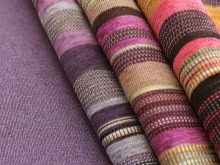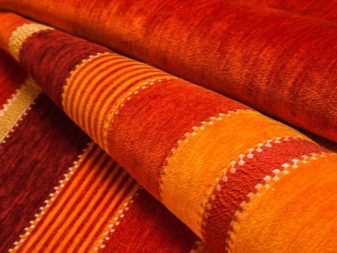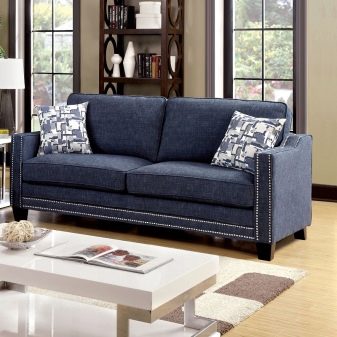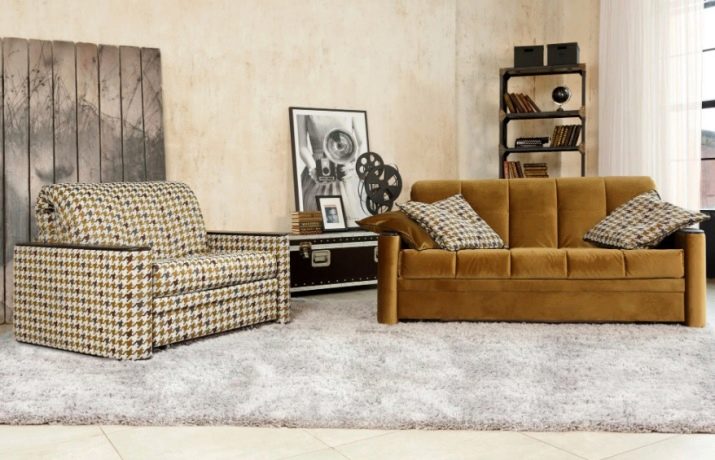Chenille for the sofa: characteristics, pros and cons, care

Soft upholstery fabrics never go out of style. They give a feeling of coziness, warmth, bring expressiveness to the interior. In addition, the high degree of comfort from touching such fabric makes it extremely popular. Chenille is a fairly popular upholstery material, competing with velveteen, micro-suede and velor. The modern market offers a huge selection of chenille shades and prints for upholstery. You can choose a tone that suits any style solution.

Characteristic
The word chenille means caterpillar. It is not surprising that a pleasant, slightly shaggy fabric got a similar name. Chenille material can consist of both natural and synthetic components. Most often, a similar fabric for a sofa has a 50/50 composition, but there are also options that are entirely made of synthetics. Such material retains its attractive appearance for a very long time if it is properly looked after. There are manufacturers who claim the service life of such fabrics up to 50 years. From the point of view of environmental friendliness, the material is absolutely safe.
In general, chenille is a kind of jacquard, only of a slightly higher quality. The weaving of fluffy and regular yarns is a complex structure. Such material is strong, durable and pleasant to the touch. It can include both threads of the same type, most often polyester, or mixed with cotton, acrylic, viscose. The fleecy structure is a warm and soft surface that can change color when it plays in the light. The price category of this fabric is average.



There are two main groups of chenille fabrics:
- glue - inexpensive, processed with glue from the inside;
- woven - better quality, not prone to pilling.


The more chenille fleecy fibers in the fabric, the heavier and denser the upholstery made of it will be. The weave itself can be of the following types:
- satin;
- tapestry;
- jacquard;
- twill.


The highest quality is jacquard weaving. Chenille has the following properties:
- exposure to water does not affect the shrinkage of the fabric;
- when exposed to high temperatures, its deformation may occur;
- practically does not wrinkle;
- elastic, can be draped;
- There are a lot of shades, as it is easily painted;
- not subject to shedding, fading.


There are three main types of chenille:
- natural - in the composition of more than half of natural fibers, it is more environmentally friendly, hypoallergenic, but also the most fragile;
- artificial - contains artificial fibers and very little natural, very durable material, durable, soft;
- synthetic - consists of acrylic and polyester, not too soft, but durable and almost never gets dirty.



Like all upholstery fabrics, chenille has both advantages and disadvantages.
Among the advantages are:
- quite durable, wear-resistant, not deformed;
- does not wrinkle and does not absorb odors;
- hypoallergenic;
- soft, pleasant to the touch;
- looks cozy and noble;
- has a lot of colors and prints.

As for the cons, here it is worth noting such qualities as:
- high price;
- unstable to moisture - any drops remain on it in the form of spots;
- the threads stretch quite easily.


What is better than velor?
Chenille upholstery is a competitor to velor, and very often buyers ask themselves - which one is better? The properties of chenille have already been mentioned. Compared to velor, it has both pros and cons. Velor is created on the basis of a glue cloth. Half of its composition is polyester, just over 20% cotton and about 30% viscose. The more durable velor consists of a synthetic upper and a cotton-type base. It can be coated to prevent puffs from forming. The palette of its shades is very diverse. There are surfaces of different texture - embossed, smooth.

Velor is as soft as chenille, does not fade and has hypoallergenic properties. Cleans well and does not stretch. But it also has disadvantages - if there is no special impregnation, velor is much easier to damage than chenille. It wears out much faster, does not tolerate dry cleaning and, most importantly, it is prone to the formation of creases. Therefore, it is very important to evaluate all the pros and cons before making a choice in favor of this or that material.
It is necessary to take into account the lifestyle of the owners of the future sofa and its purpose. If there are animals in the house, it is better to choose velor, but only with a Teflon coating and impregnation.
In the case of a calm measured life of the owners and the absence of animals and children, chenille is ideal.

Colors
The rich color range is one of the main advantages of this fabric. Among the most popular colors and shades, the following are distinguished.
Blue and light blue. The variety of shades in this range allows you to choose the upholstery from light blue to deep royal blue.

Green. Monochrome or patterned green chenille looks expensive and respectable.

Brown... A noble and discreet brown sofa - an interior classic.

Gray. Another neutral, restrained shade, noble and effective at the same time.

Purple. A mysterious palette will add an expressive and catchy touch to any design.

It is very important that the color of the sofa does not contradict the composition as a whole, but fits organically into it. In addition, the color scheme should fully match the style of the room.

How to care?
Chenille won't be too much of a hassle to care for. Almost all stains can be removed from it using any means based on water or soap solution.If you've smudged your couch with lipstick or put on a greasy stain, try treating the stain with a solution of water and ammonia. You can also safely dry clean with products containing trichlorethylene. If there are covers on your sofa, then you can machine wash them at a temperature of no more than 40 degrees. In this case, neutral detergents must be added.
It is prohibited:
- bleach;
- squeeze;
- dry under the sun;
- use aggressive means;
- put the sofa in the immediate vicinity of hot heating appliances;
- iron chenille.

Adhesive types of fabrics cannot be washed, the use of solutions containing alcohol is excluded. Otherwise, bald patches may appear. Ideally, you should vacuum your sofa daily with a long-haired vacuum cleaner.
If in doubt, leave it to a professional to clean, or use a stain remover for this type of fabric.

Review overview
In general, reviews of chenille upholstery are positive. Buyers mark its not too high price. Most of all, the aesthetic properties of sofas are attracted - they have a spectacular, noble look, a rich palette. You can choose the fabric, both monochrome and with ornaments in any style for almost any interior.
Among the minuses, it is most often noted that puffs from the claws of animals are formed on the tissue.

You can find out how to choose a sofa below.








